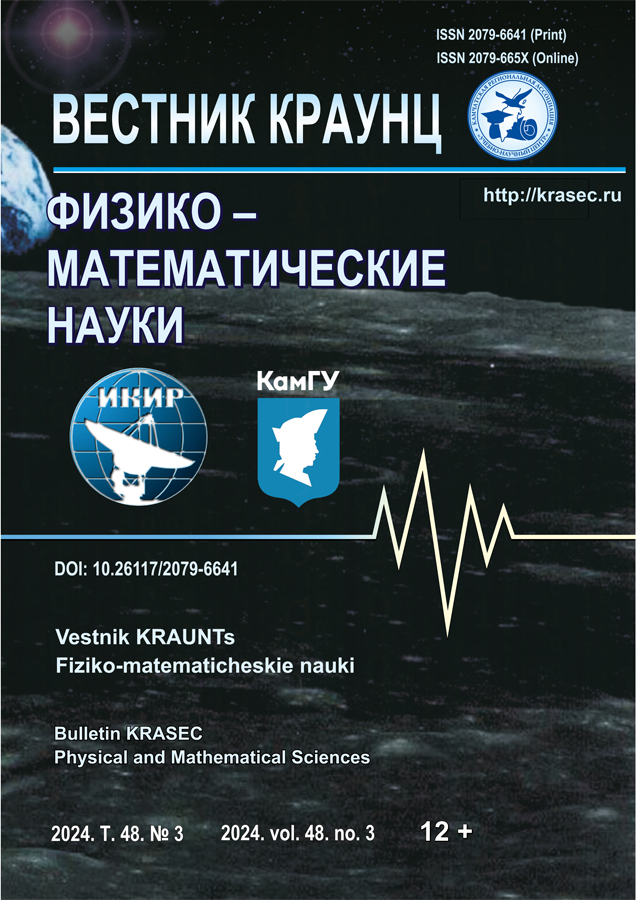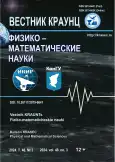Boundary Value Problems for the Three-Dimensional Helmholtz Equation in the Unbounded Octant, Square and Half Space
- Authors: Arzikulov Z.O.1
-
Affiliations:
- Fergana Polytechnic Institute
- Issue: Vol 48, No 3 (2024)
- Pages: 7-19
- Section: Mathematics
- URL: https://journal-vniispk.ru/2079-6641/article/view/277534
- DOI: https://doi.org/10.26117/2079-6641-2024-48-3-7-19
- EDN: https://elibrary.ru/MRZFAU
- ID: 277534
Cite item
Full Text
Abstract
At present, the results of the study of boundary value problems for the two-dimensional Helmholtz equation with one and two singular coefficients are known. In the presence of two positive singular coefficients in the two-dimensional Helmholtz equation, explicit solutions of the Dirichlet, Neumann and Dirichlet-Neumann problems in a quarter plane are expressed through a confluent hypergeometric function of two variables. The established properties of the confluent hypergeometric function of two variables allow us to prove the theorem of uniqueness and existence of a solution to the problems posed.In this paper, we study the Dirichlet, Neumann, and Dirichlet-Neumann problems for the three-dimensional Helmholtz equation at zero values of singular coefficients in an octant, a quarter of space, and a half-space. Uniqueness and existence theorems are proved under certain restrictions on the data. The uniqueness of solutions of which is proved using the extremum principle for elliptic equations. Using the known fundamental (singular) solution of the Helmholtz equation, solutions to the problems under study are written out in explicit forms.
Full Text
Introduction
It’s known, that the Helmholtz equation has a variety of applications in physics and other sciences, including the wave equation, the diffusion equation, and the Schrödinger equation for a free particle.
The Helmholtz equation often arises in the study of physical problems involving partial differential equations (PDEs) in both space and time. The Helmholtz equation, which represents a time-independent form of the wave equation, results from applying the technique of separation of variables to reduce the complexity of the analysis [15].
The two-dimensional analogue of the vibrating string is the vibrating membrane, with the edges clamped to be motionless. The Helmholtz equation was solved for many basic shapes in the 19th century: the rectangular membrane by Siméon Denis Poisson in 1829, the equilateral triangle by Gabriel Lamé in 1852, and the circular membrane by Alfred Clebsch in 1862. The elliptical drumhead was studied by Émile Mathieu, leading to Mathieu’s differential equation.
Two- and more-dimensional Helmholtz equations
and their related boundary-value problems have been investigated in a large number of papers [1–3, 12–14].
On the other hand, the equation has important applications. In 1952 Kapilevich [18] has solved Dirichlet and Neumann problems for multidimensional Helmholtz equation with singular coefficient
(1)
in the half-space. In 1978 Marichev [19] has investigated two-dimensional Helmholtz equation with two singular coefficients
There are many works [6–9, 11] devoted to the Helmholtz equation (1). For instance, in the work [10] the Dirichlet problem fot the singular Helmholtz equation (1) for is solved explicitly.
Generally speaking, our further goal is to pose and investigate boundary value problems for Helmholtz equation with three singular coefficients
(2)
in some infinite domains.
For beginning, in the present paper, we study the Dirichlet, Neumann and Dirichlet-Neumann boundary value problems for equation (2) at and in the unbounded domains – in an octant, square of the space and half-space.
The Dirichlet problem for the Helmholtz equation in the first octant
Let us consider the following Helmholtz equation
(3)
in the infinite domain
The Dirichlet problem . Find a regular solution to the Helmholtz equation (3) in the class of functions , satisfying the conditions
(4)
(5)
(6)
(7)
About the authors
Zafarjon Odilovich Arzikulov
Fergana Polytechnic Institute
Author for correspondence.
Email: zafarbekarzikulov1984@gmail.com
ORCID iD: 0009-0004-2965-4566
Doktorant, Fac. of Phys. & Department of Higher Mathematics
Uzbekistan, 150107, Ferganskaya str., 86, FerganaReferences
- Hu G., Rathsfeld A. Radiation conditions for the Helmholtz equation in a half plane filled by inhomogeneous periodic material, Journal of Differential Equations, 2024. vol.388, pp.215–252.
- Chandler-Wilde S. N. Boundary value problems for the Helmholtz equation in a half-plane, Conference: Third International Conference on Mathematical and Numerical Aspects of Wave Propagation Phenomena, 1994. vol. 94, pp. 1–12.
- Frank-Olme S., Ernst S. Boundary Value Problems for the Helmholtz Equation in an Octant, Integral Equations and Operator Theory, 2008. vol. 62, pp. 269–300.
- Sveshnikov A. G., Bogolyubov A. N., Kravtsov V. V. Lectures on Mathematical Physics. Moscow: Moscow State University, 1993. 352 pp. (in Russian)
- Gradshteyn I. S., Ryzhik I. M. Table of integrals, series and products. Amsterdam: Academic Press, 2007. 1172 pp.
- Ergashev T. G., Safarbaeva N. M. Holmgren’s problem for a multidimensional Helmholtz equation with one singular coefficient, Bulletin of the Institute of Mathematics, 2020. vol. 1, pp. 127 – 135.
- Ergashev T. G., Hasanov A. Holmgren problem for elliptic equation with singular coefficients, Vestnik KRAUNC. Fiz.-mat. nauki., 2020. vol. 32, no. 3, pp. 159 – 175.
- Ergashev T. G., Hasanov A. Fundamental solutions of the bi-axially symmetric Helmholtz equation, Uzbek Mathematical Journal, 2018. vol. 1, pp. 55 – 64.
- Ergashev T. G. Third double-layer potential for a generalized bi-axially symmetric Helmholtz equation, Ufa Mathematical Journal, 2018. vol. 10, pp. 111 – 121.
- Repin O. A., Lerner M. E. On the Dirichlet problem for the generalized bioxially symmetric Helmholtz equation in the first quadrant, Vestnik Samarsk. Gos. Tekh. Universiteta, Ser. fiz.-matem. nauki, 1998. vol. 6, pp. 5 – 8 (in Russian).
- Samko S.G., Kilbas A.A., Marichev O.I. Fractional integrals and derivatives. Theory and applications. Amsterdam: Gordon and Breach Science Publishers, 1993. 976 pp.
- Juraev D. A., Agarwal P., Elsayed E. E., Targyn N. Applications of the Helmholtz equation, Advanced Engineering Days, 2023. vol. 8, pp. 28 – 30.
- Juraev D. A. On the Cauchy problem for matrix factorizations of the Helmholtz equation in a bounded domain, Siberian Electronic Mathematical Reports, 2018. vol. 15, pp. 11 – 20.
- Juraev D. A. The construction of the fundamental solution of the Helmholtz equation, Reports of the Academy of Sciences of the Republic of Uzbekistan, 2012. vol. 2, pp. 14 – 17.
- Zwillinger D. Handbook of Differential Equations. Boston, MA Academic Press, 1997. 129 pp.
- Tikhonov, A. N. and Samarskii, A. A. Equations of Mathematical Physics, Dover Publ. New York: Dover Publ 1990. 829 pp.
- Budak, B. M., Samarskii, A. A., and Tikhonov, A. N. Collection of Problems on Mathematical Physics. Moscow: Nauka, 1980. 829 pp. (in Russian).
- Kapilevich M.B. On one equation of mixed elliptic-hyperbolic type., Matematicheskii sbornik, 1952. vol. 30(72), pp. 11 – 38 (in Russian).
- Marichev O.I. Integral representation of solutions of the generalized biaxially symmetric Helmholtz equation and its inversion formula., Differensialniye uravneniya, 1978. vol. 14, pp. 1824 – 1831 (in Russian).
Supplementary files










